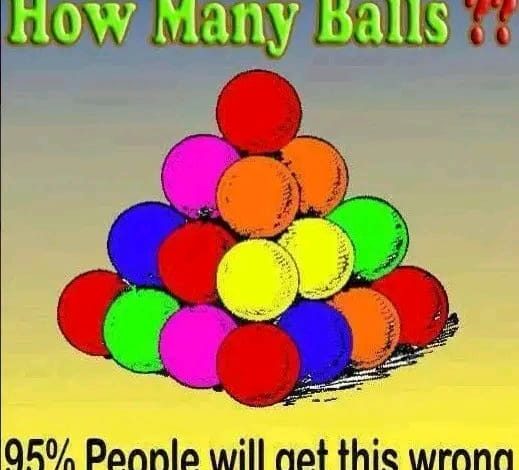The Challenge of Visual Puzzles: Analyzing the ‘How Many Balls?’ Conundrum

ADVERTISEMENT
The Challenge of Visual Puzzles: Analyzing the ‘How Many Balls?’ Conundrum
Introduction:
Visual puzzles like the “How Many Balls?” image challenge not only entertain but also serve to stimulate cognitive processing and problem-solving skills. These puzzles are designed to be deceptive, often leading a high percentage of people to incorrect conclusions. This particular image claims that 95% of people will get the answer wrong, highlighting the difficulty and tricky nature of such visual challenges.
Discussion:
1. Structure of the Puzzle:
ADVERTISEMENT
- The image presents a pyramid of colored balls, arranged in layers. To solve the puzzle, one must understand the arrangement of spheres in a tetrahedral structure. Each layer’s number of balls increases as you move from the top of the pyramid to the base, following a pattern.
2. Common Mistakes:
- Many people quickly count the visible balls but overlook those hidden from view. The key to solving this puzzle lies in recognizing the full depth of the pyramid, not just the surface.
3. Mathematical Explanation:
- The solution involves calculating the total number of balls in a tetrahedral number sequence. For example, if there are four layers, the number of balls is calculated as 1 (top layer) + 3 (second layer) + 6 (third layer) + 10 (fourth layer) = 20 balls in total.
4. Psychological Aspect:
- The claim that 95% of people will answer incorrectly plays into the psychological element of the puzzle, increasing its allure and challenge. This assertion makes the puzzle more engaging as people are driven to prove it wrong by attempting to be in the 5% who get it right.
Conclusion: Visual puzzles like the “How Many Balls?” image are more than just simple diversions; they are a blend of art, mathematics, and psychology. They challenge us to see beyond the obvious and encourage deeper analytical thinking and attention to detail. Whether used as educational tools, brain teasers, or just for fun, these puzzles play a valuable role in cognitive development and problem-solving training.
Engaging with such puzzles can be a delightful and educational exercise, helping to sharpen one’s mind and potentially improving skills in spatial reasoning and mathematics. Enjoy the challenge and remember, the key is to look deeper than the surface!
ADVERTISEMENT




